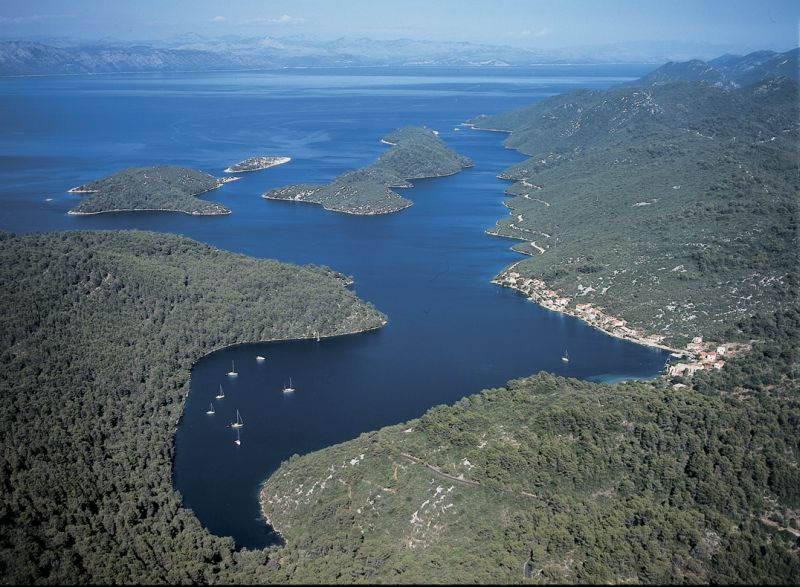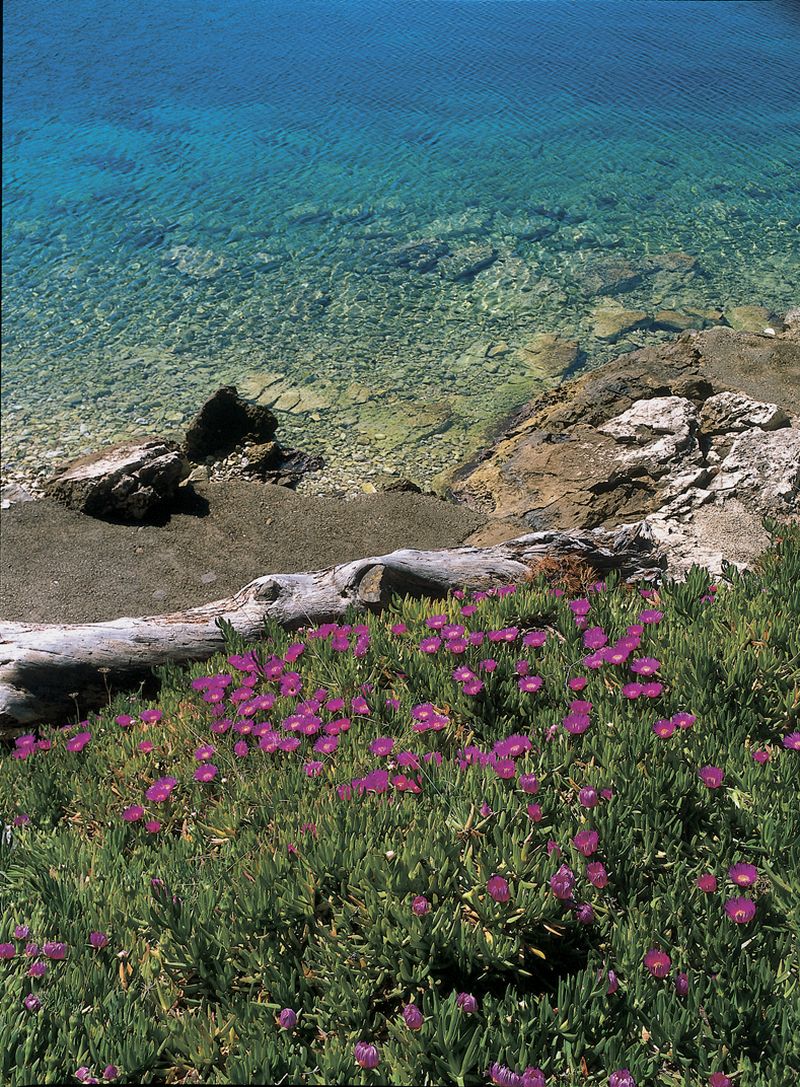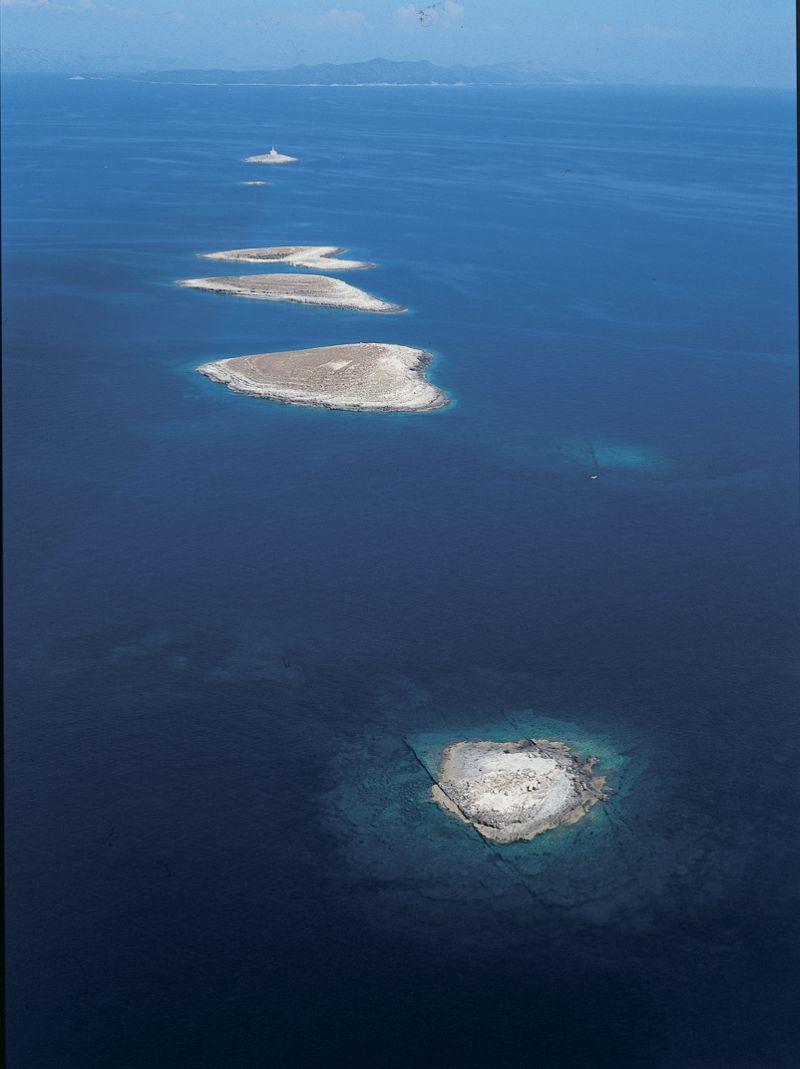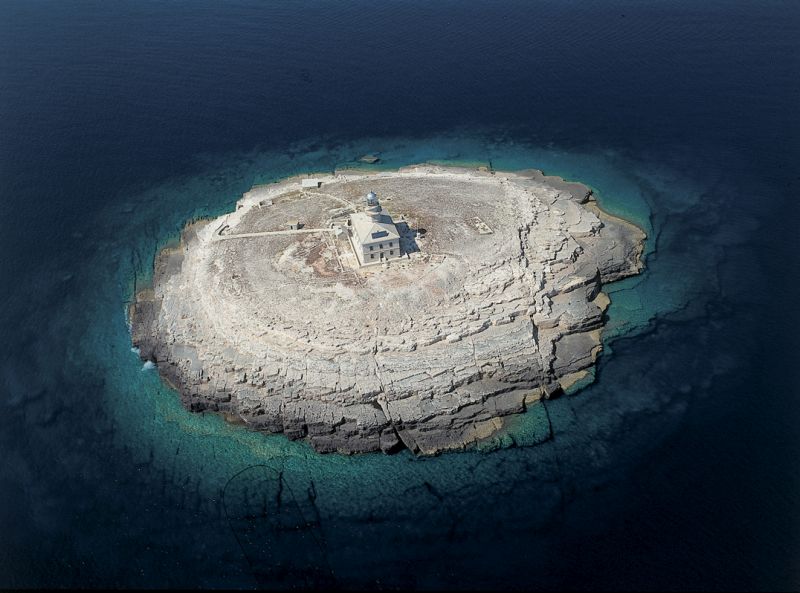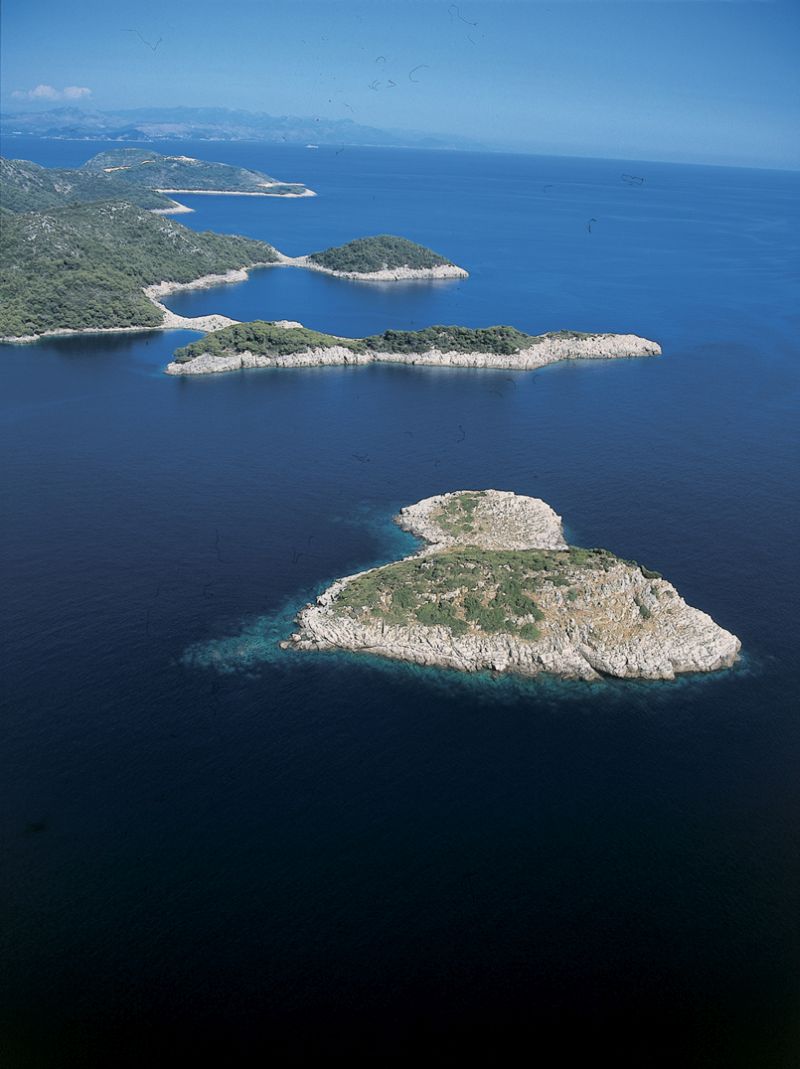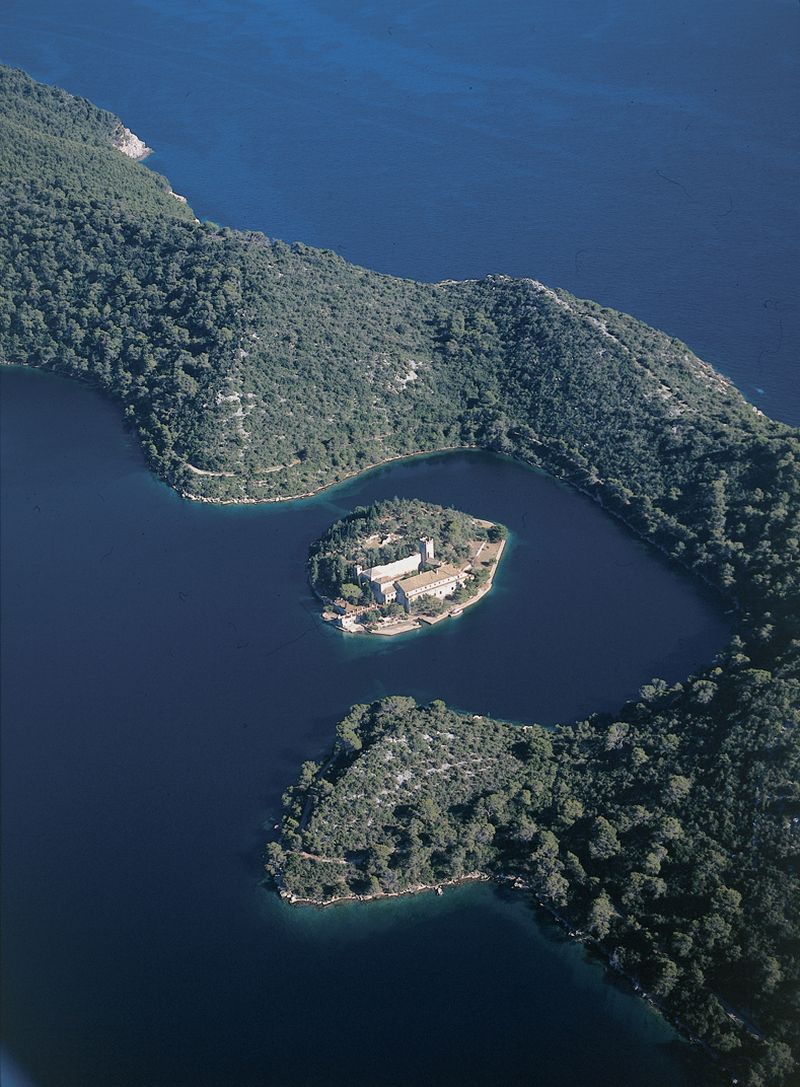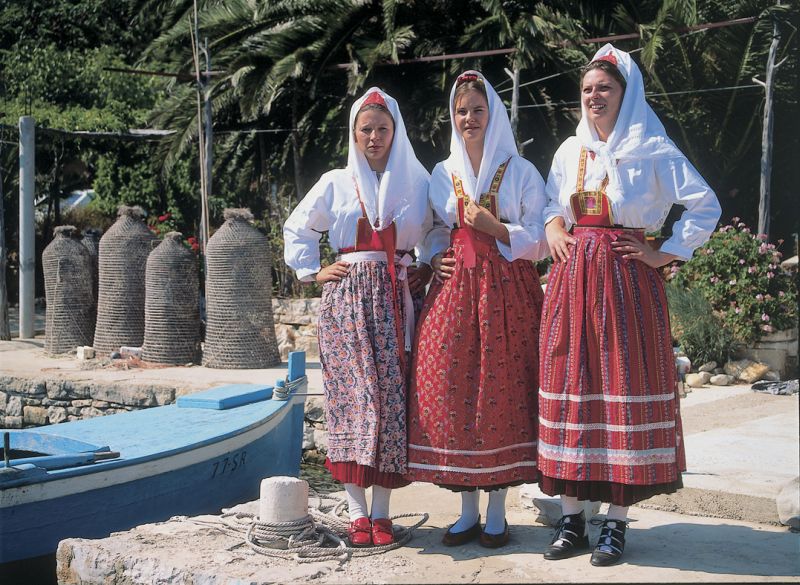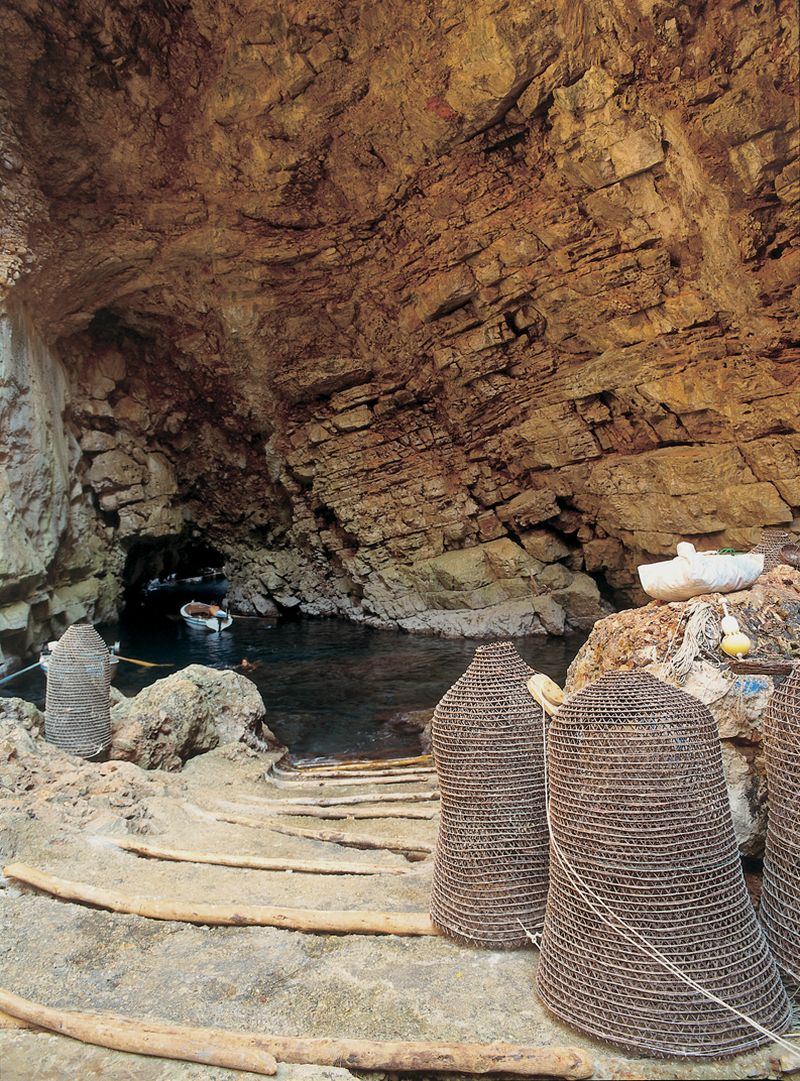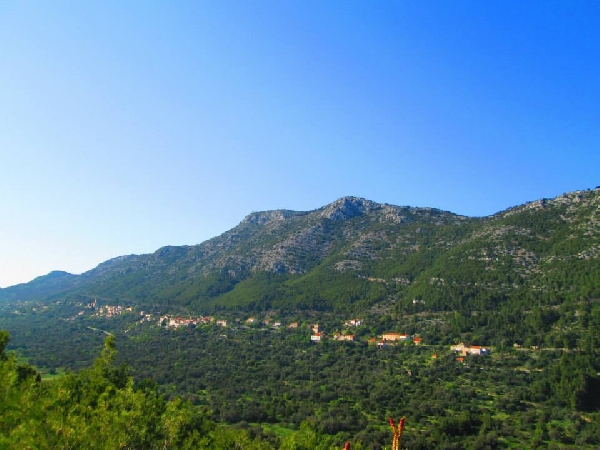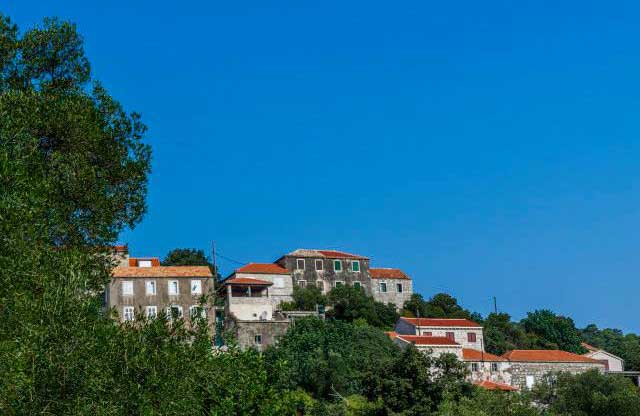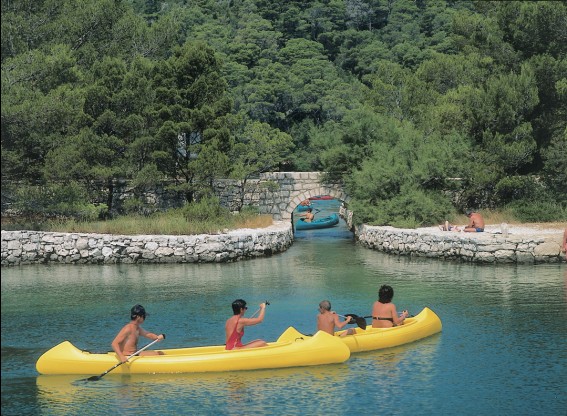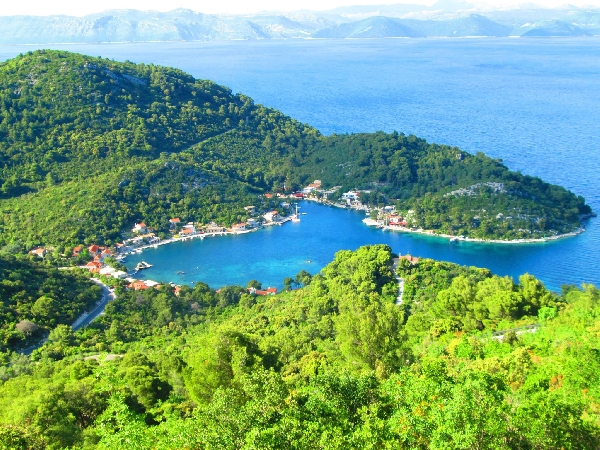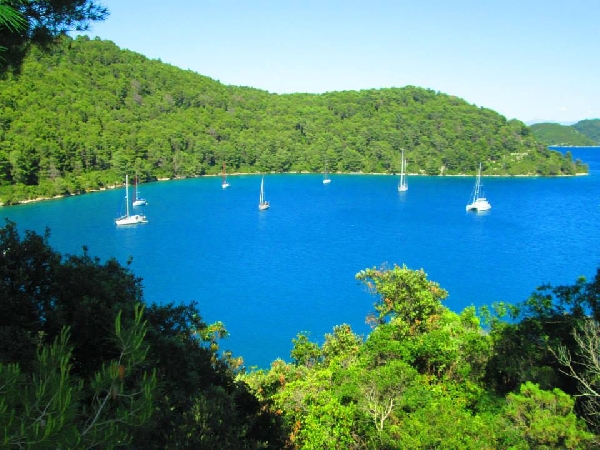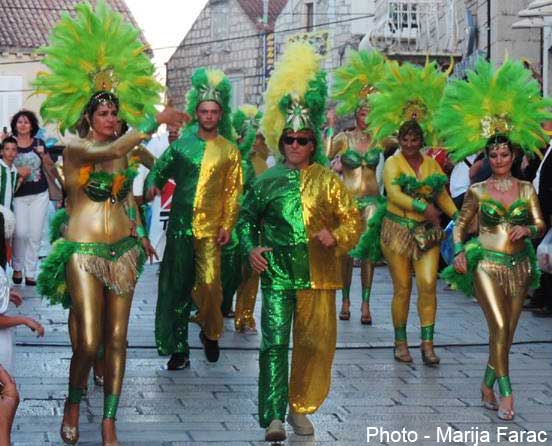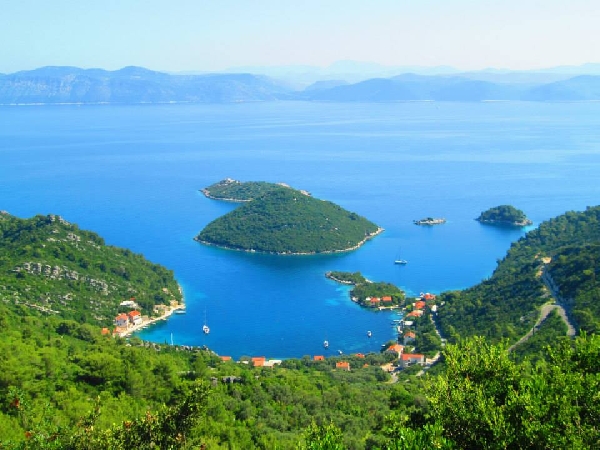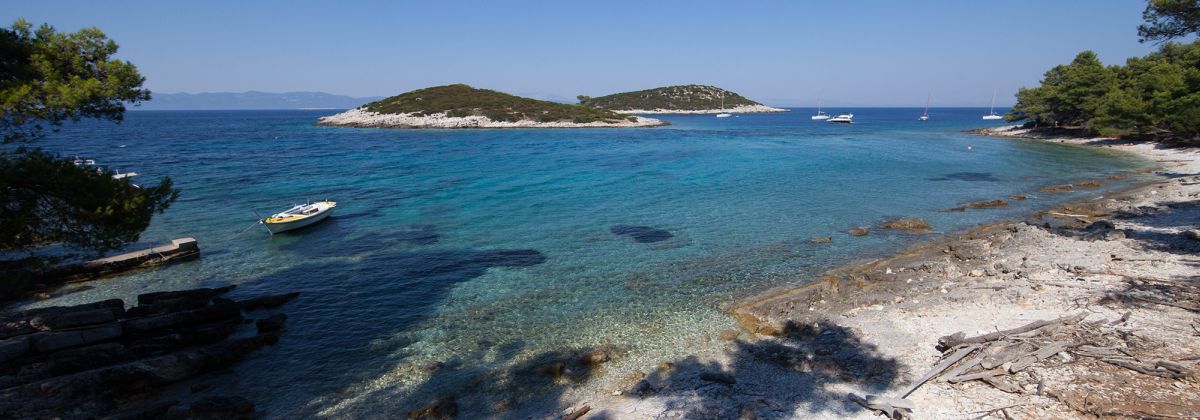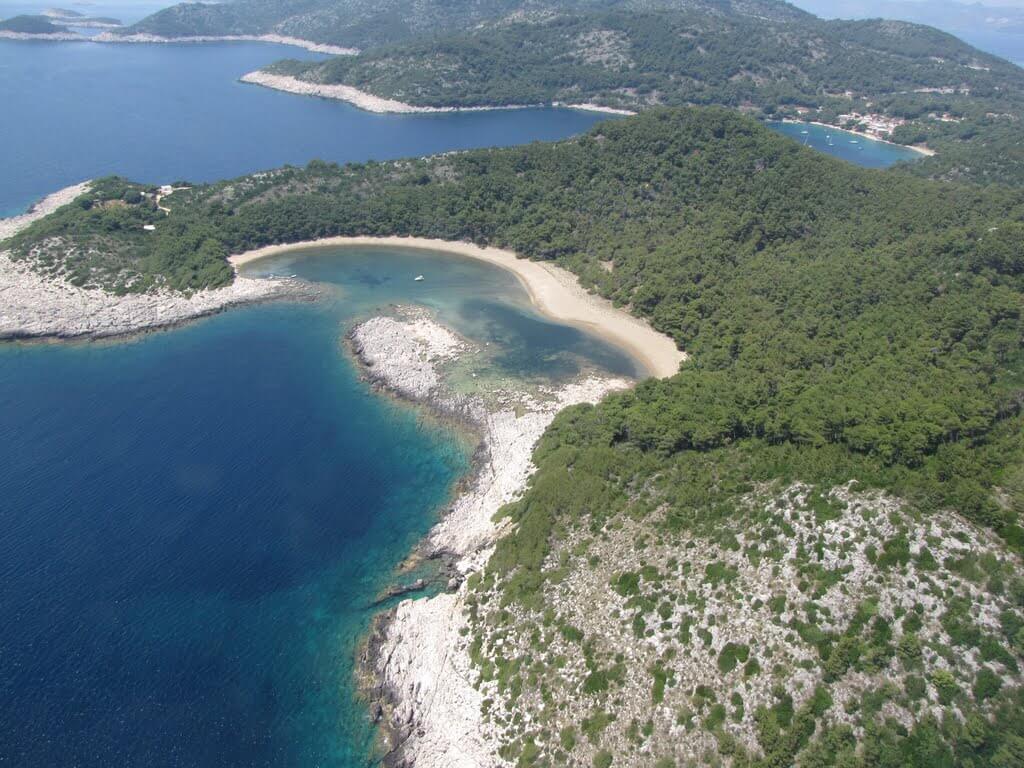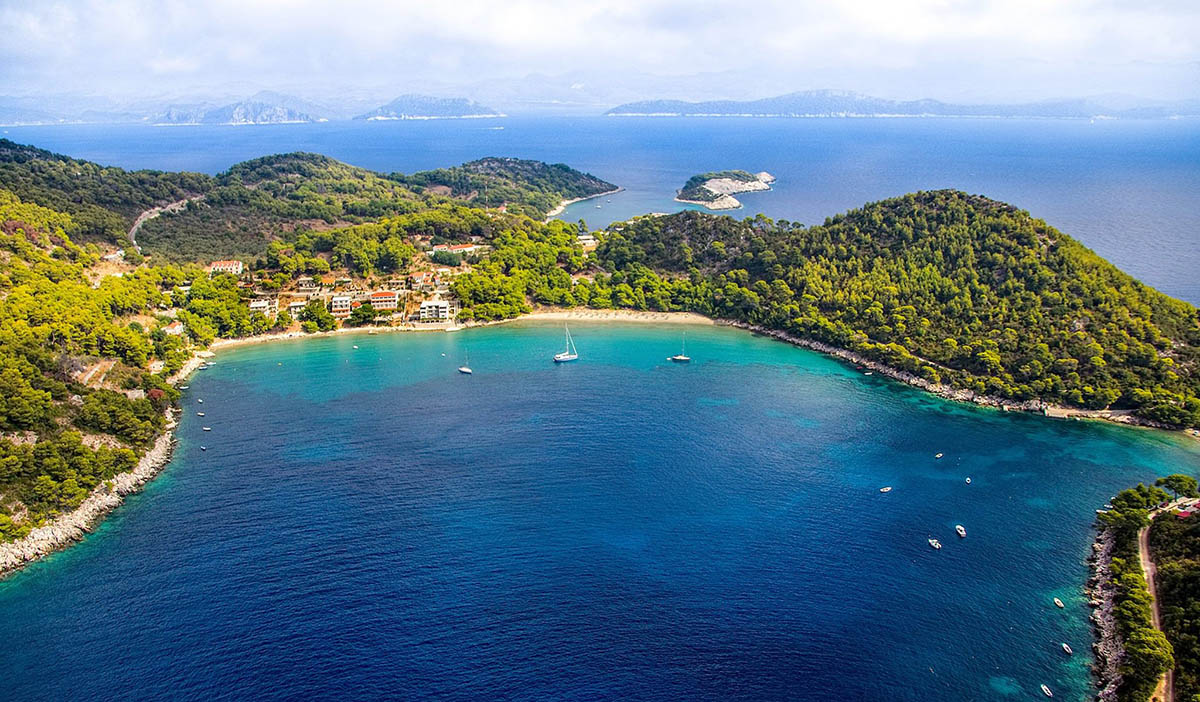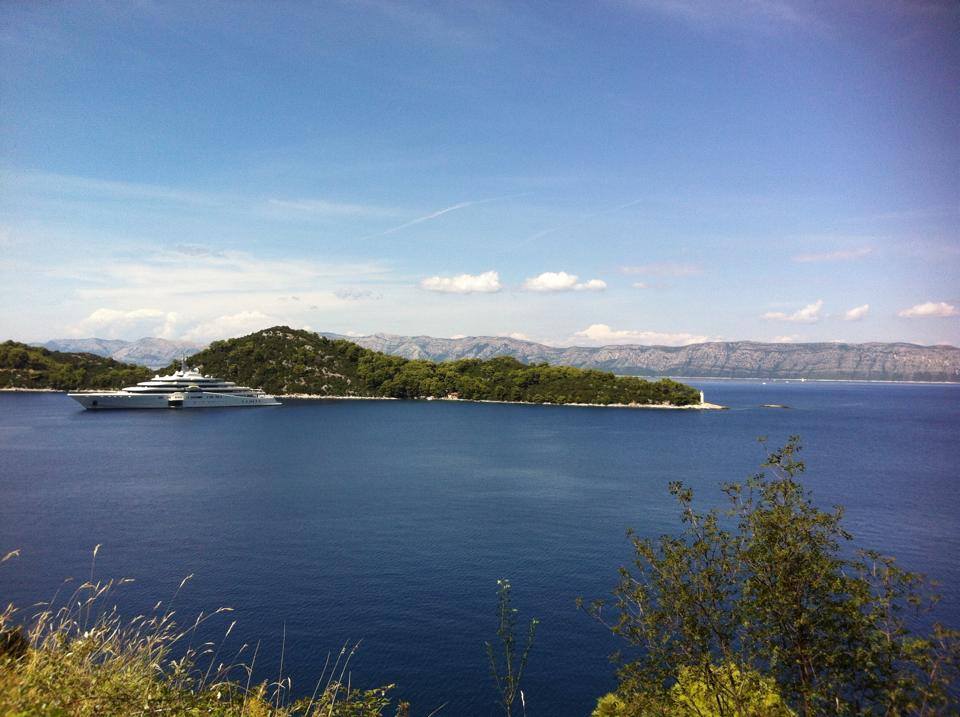Mljet
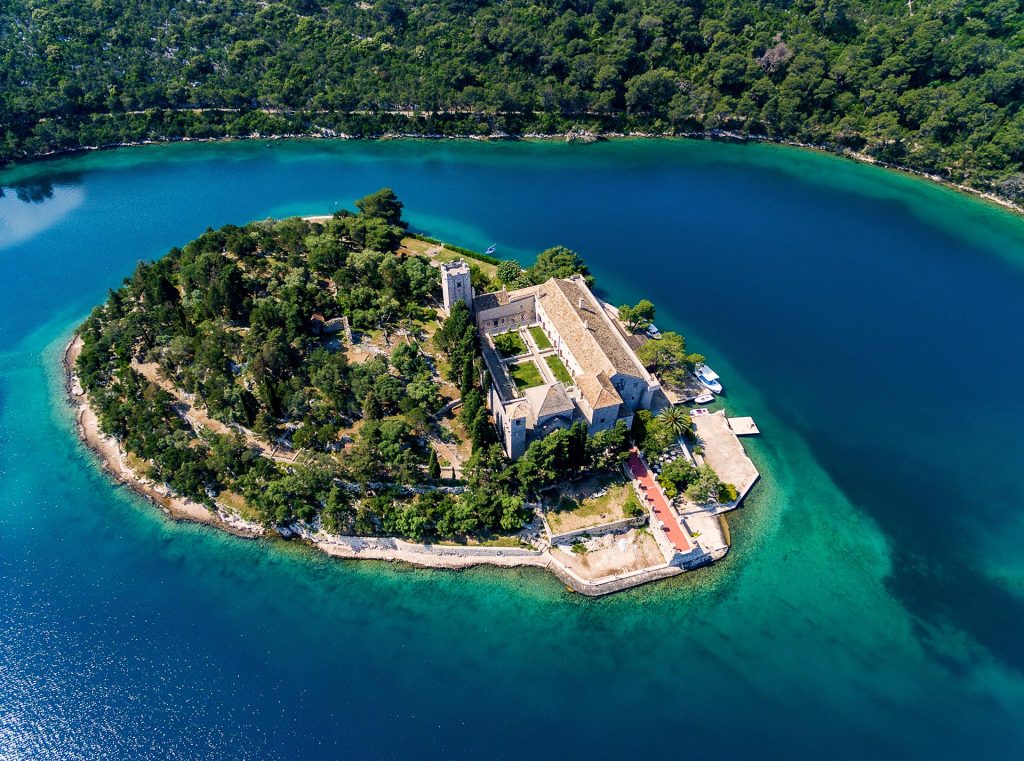 Mljet – the first large island we come upon while sailing the from the southeast in Croatian waters. In historical times, the entire island was inhabited by the Illyrians. The Greeks, on their way to Lumbarda (island of Korčula) and other Adriatic settlements arrived there stayed due to the water and bad weather. The island was also inhabited by the Romans, who left behind archaeological remnants, the most significant of which is the palace in Polače harbor, as well as the names of the island heights, hills and reefs, unquestionable proof of their residence on the island.
Mljet – the first large island we come upon while sailing the from the southeast in Croatian waters. In historical times, the entire island was inhabited by the Illyrians. The Greeks, on their way to Lumbarda (island of Korčula) and other Adriatic settlements arrived there stayed due to the water and bad weather. The island was also inhabited by the Romans, who left behind archaeological remnants, the most significant of which is the palace in Polače harbor, as well as the names of the island heights, hills and reefs, unquestionable proof of their residence on the island.
Mljet is Croatia’s greenest island with lush Mediterranean vegetation, clear and clean sea, a gentle, sandy shoreline and a wealth of underwater sea life. This island is well known for its southern sorts of white and red wine, which receive a special flavour and aroma from the sun and the specific Mljet soil. The island is also well known for its goat’s cheese and honey which, in the past, was served in emperor’s courts, and mostly for the warmness with which the islanders greet visitors to their island.
The Island of Mljet has a daily ferry connection with Dubrovnik and in the summer, with the Islands of Korčula and Lastovo. The ferry which connects Prapratno and Sobra is in function throughout the year. During the height of the season, the island is connected with Dubrovnik, Korčula, Hvar, Split and Rijeka by ferries.
During the summer months, numerous tourism and excursion boats arrive to the area of the Mljet National Park (at the harbours of Place and Pomena) from Dubrovnik, Korčula, Makarska and the Pelješac peninsula.
History – Mljet
The island has various names in documents from the past: de Melita, de Meleta, da Mlete, de la Melida, da Melta, da Malta, di Meleda, Melitensis, Melitae – all equally beautiful and melodious, as is the island itself.
The word Melita – Melite in Greek has the same meaning as the Latin word for honey – mell, mellis. The meaning of the name of the island comes from the word for honey, as in the past, its woods were inhabited by many swarms of bees. Those who first come to this island instantly fall in love with it, and always gladly return.
The island’s past recalls many things and people: Odyssey and his nymph Calypso, the apostle Paul, the poet Opiana, the Roman Emperor Augustus, the German military leader Odoacer with his “comes domesticorum” Pierius, the ancient Illyrians, the Croatian-Slavic inhabitation of the island and their battles with the Roman army, the Dubrovnik nobles who ruled over the island, as did the Abbots of St. Mary and later, the Venetian knights, the fall of the Dubrovnik Republic, the arrival of Napoleon’s army and the English war ships, the hundred years of Austrian rule, the first Italian occupation of the island, the rule of the anti-people’s regime under the Kingdom of Yugoslavia, the second occupation and the annexation of the island by Mussolini’s Italy from 1941 to 1943, the anti-fascist movement and the liberation of the island in 1944, and the half-century of Communist rule.
Since 1990, Mljet, together with the remaining Croatian islands has been an indivisible part of the free and independent Republic of Croatia, which was the centuries long dream for many generations of the people of Mljet.
Babino Polje
Babino Polje is one of the oldest settlements on the island of Mljet. The town is situated in the foothills of the Veliki and Mali Grad hills and comprised of three villages: Zadublje, Srčenovići and Zabriježe. Beneath the town is the vast and fertile Babino Polje, after which the town was named. This is the central and largest island town.
During the time of the Dubrovnik Republic, the Venetian Rector lived here and chaired the island region. During the 11th century, the first church was erected and dedicated to St. Pankracij, the first patron saint of the island. The town is the centre of the Mljet municipality, and is home to their elementary school, the post office, health centre with an outpatient clinic, the parish office of St. Vlaho, the cultural-artistic society “Natko Nodilo”, the cultural centre “Zabriježe” and more. The town has several shops and a cafe.
Information
Mljet Tourist Board
Zabriježje 2,
20225 Babino Polje
info@mljet.hr
www.mljet.hr
Tel/Fax: +385 (0) 20 7807992
Goveđari
Goveđari is a settlement which arose at the end of the 18th century. A document dating back to 1793 proves the theory. This document in question is a contract signed by the monks of the Mljet monastery of St. Mary, Benedikt Gleđ, Bernard Sivrić, Placid Guska and Luiđi Garmoljez, with the consent of the monastery representative, the procurator Nikola Nikolova Pucić and Don Antunov Restić with Vicko Basta from Babino Polje and the brothers Nikola and Petar Milić.
The subject of the document regards the brother’s inhabitation of the area at the Pomjente field, thus becoming the first inhabitants of the village Goveđari. The village is connected by road to Pomena, Polače and the Great Lake. Nearby is the Church of St. Nicholas, built in the early 20th century together with its Parish office.
The Roman Catholic parish of Goveđari was founded in 1897 and includes the following settlements: Goveđari, Polače, Babine Kuće, Njivice, Soline and Pomena.
Information
Mljet Tourist Board
Zabriježje 2,
20225 Babino Polje
info@mljet.hr
www.mljet.hr
Tel/Fax: +385 (0) 20 7807992
Maranovići
Maranovići is well known for its vast olive plantations. The parish Church of St. Anthony (Antun) was built on the location of the old Gothic Church of St. Anthony, which was mentioned along with the guild in Maranovići at the beginning of the 17th century.
Today’s Church of St. Anthony was built during the first half of the 19th century. The church collection includes a lovely chalice (117×115 mm) of gold-plated silver. The chalice has an exceptional Gothic form and dates back to the second half of the 15th century. It likely came from the old Church of Mary of the Hills, located above the village and thought to have been built in the 14th-15th centuries, as the church shows clear transitional elements between the Romantic and Gothic styles.
The Roman Catholic parish in Maranovići was established in 1769.
Information
Mljet Tourist Board
Zabriježje 2,
20225 Babino Polje
info@mljet.hr
www.mljet.hr
Tel/Fax: +385 (0) 20 7807992
Okuklje
Okuklje, while being a relatively small village has a well sheltered harbour and is a favourite anchoring place for many boaters.
The Church of St. Nicholas, built in the early part of the 16th century, sits on the hill above the harbour. It was renovated in 1990. The monastery of St. Dominic is next to the church. During the 17th century, pirates and outlaws looted and torched Okuklje several times. In 1693, the entire town was looted and torched and then abandoned, as the residents fled to Korita and Maranovići. Okuklje is the oldest Croatian island town on the coast. It was established by the inhabitants of Vrhmljeca during the latter half of the 15th century.
This was a fishing and shipping town. Today, the village lives again as an eternal symbol of human indestructibility.
The Okuklje harbour is in the most sheltered bay on the island of Mljet. The Italians called it Porto Cammera. The town has several seafood restaurants and vacation homes.
Information
Mljet Tourist Board
Zabriježje 2,
20225 Babino Polje
info@mljet.hr
www.mljet.hr
Tel/Fax: +385 (0) 20 7807992
Polače
The settlement of Polače is located along the fields (polače) of antiquity from which it received its name. Polače is the largest and safest Mljet harbour, as it is surrounded by islands: Tajnik, Moračnik, Ovrata and Kobrava. The harbour has a long and rich history. Due to its excellent sailing characteristics and the ruins of structures from ancient times, it is visited by many yachts, sailboats and other vessels.
There are several villas offering private accommodations, as well as cafes and restaurants, i.e. ‘Stella maris’, ‘Ogigija’ and others. There is also a bakery and grocery store. In more recent history (about 1830), the harbour was inhabited by the families of Đuro Dabelić and Stjepan Nodilo.
Information
Mljet Tourist Board
Zabriježje 2,
20225 Babino Polje
info@mljet.hr
www.mljet.hr
Tel/Fax: +385 (0) 20 7807992
Pomena
Pomena (50 residents), once the fishing village of Goveđari, is the centre of the hospitality and tourism on the entire island of Mljet. The hotel ‘Odisej’ with its numerous sports and recreational possibilities gives a new impulse to the tourism development of the entire island.
The dense pine woods, vicinity to the Small and Great Lakes and the islets of Crna Seka, Galicija and Pomeštak give this town a gentle Mediterranean feel. Hospitality facilities with a home feel are available for visitors.
Information
Mljet Tourist Board
Zabriježje 2,
20225 Babino Polje
info@mljet.hr
www.mljet.hr
Tel/Fax: +385 (0) 20 7807992
Prožura
Prožura is an old medieval settlement which grew around the Church of the Hold Trinity and its monastery. The church bears the markings of Dubrovnik Gothic chapels of the second half of the 15th century. It was likely constructed by the Lokrum Benedictines when they came into possession of the land at Prožura in 1477.
The Church of the Holy Trinity contains the most significant and beautiful art on the island of Mljet: the Romanic bronze crucifix. Just above Prožura is the Chapel of St. Martin with its small cloister from the 14th century. The Chapel of St. Rok with its semicircular apse is from more recent times.
The square tower dominates the hill above town, bearing testimony to the pirate attacks of the 17th century in the hidden Mljet highland villages. Pavao Gracić, the Bishop of Ston from 1635 to 1652, was born in Prožura.
Information
Mljet Tourist Board
Zabriježje 2,
20225 Babino Polje
info@mljet.hr
www.mljet.hr
Tel/Fax: +385 (0) 20 7807992
Saplunara
Saplunara is a settlement with 32 residents. Due to the breathtaking landscape, Saplunara, Blaca and Pinjevac have been proclaimed a Reserve of Natural Rarity. The stone pines which naturally grow here are among the loveliest of their kind, while the fine sandy inlets with their reefs are reminiscent of those sections of the planet Earth which are rightfully considered to be the pearls and jewels of this world. This is a place to come to if you want to get away from the noise, bustle and noxious gases of European cities.
Its name stems from the Latin word sabulum, meaning sand. The inlet Saplunara faces the open sea to the southwest, it is about 1 kilometre in length and about 350 metres in width at its central, narrowest section.
The sandy beaches are divided into Small and Great Saplunara. The town Saplunara was established by the residents of Korita after World War II. Today, there are some twenty beautiful homes here, where numerous tourists stay. The largest is Villa Bašica, with 20 rooms, a restaurant and other tourism and recreational facilities. Saplunara is connected with Babino Polje and Pomena by the island highway through Korita and Maranovići.
Information
Mljet Tourist Board
Zabriježje 2,
20225 Babino Polje
info@mljet.hr
www.mljet.hr
Tel/Fax: +385 (0) 20 7807992
Sobra
Sobra (68 residents) is the old fishing port of Babinopoljaca. This town was settled in the period between the two World Wars.
This is the maritime-transport centre of the entire island. Ferries and ships arrive at Sobra daily from Dubrovnik, and two to three times a week, ships on the route Rijeka-Split-Dubrovnik stop over here. From this point, buses transport passengers and tourists to the other island towns, as well as to the Odisej Hotel in Pomena. There is the port authority, shops and several restaurants and pizzerias, as well as private bed and breakfasts in newly constructed villas. The town has its own waterworks, and is supplied with water from the source at nearby Blatina.
Information
Mljet Tourist Board
Zabriježje 2,
20225 Babino Polje
info@mljet.hr
www.mljet.hr
Tel/Fax: +385 (0) 20 7807992
- Babino Polje
-
Babino Polje
Babino Polje is one of the oldest settlements on the island of Mljet. The town is situated in the foothills of the Veliki and Mali Grad hills and comprised of three villages: Zadublje, Srčenovići and Zabriježe. Beneath the town is the vast and fertile Babino Polje, after which the town was named. This is the central and largest island town.
During the time of the Dubrovnik Republic, the Venetian Rector lived here and chaired the island region. During the 11th century, the first church was erected and dedicated to St. Pankracij, the first patron saint of the island. The town is the centre of the Mljet municipality, and is home to their elementary school, the post office, health centre with an outpatient clinic, the parish office of St. Vlaho, the cultural-artistic society “Natko Nodilo”, the cultural centre “Zabriježe” and more. The town has several shops and a cafe.
Information
Mljet Tourist Board
Zabriježje 2,
20225 Babino Polje
info@mljet.hr
www.mljet.hr
Tel/Fax: +385 (0) 20 7807992 - Goveđari
-
Goveđari
Goveđari is a settlement which arose at the end of the 18th century. A document dating back to 1793 proves the theory. This document in question is a contract signed by the monks of the Mljet monastery of St. Mary, Benedikt Gleđ, Bernard Sivrić, Placid Guska and Luiđi Garmoljez, with the consent of the monastery representative, the procurator Nikola Nikolova Pucić and Don Antunov Restić with Vicko Basta from Babino Polje and the brothers Nikola and Petar Milić.
The subject of the document regards the brother’s inhabitation of the area at the Pomjente field, thus becoming the first inhabitants of the village Goveđari. The village is connected by road to Pomena, Polače and the Great Lake. Nearby is the Church of St. Nicholas, built in the early 20th century together with its Parish office.The Roman Catholic parish of Goveđari was founded in 1897 and includes the following settlements: Goveđari, Polače, Babine Kuće, Njivice, Soline and Pomena.
Information
Mljet Tourist Board
Zabriježje 2,
20225 Babino Polje
info@mljet.hr
www.mljet.hr
Tel/Fax: +385 (0) 20 7807992 - Maranovići
-
Maranovići
Maranovići is well known for its vast olive plantations. The parish Church of St. Anthony (Antun) was built on the location of the old Gothic Church of St. Anthony, which was mentioned along with the guild in Maranovići at the beginning of the 17th century.
Today’s Church of St. Anthony was built during the first half of the 19th century. The church collection includes a lovely chalice (117×115 mm) of gold-plated silver. The chalice has an exceptional Gothic form and dates back to the second half of the 15th century. It likely came from the old Church of Mary of the Hills, located above the village and thought to have been built in the 14th-15th centuries, as the church shows clear transitional elements between the Romantic and Gothic styles.
The Roman Catholic parish in Maranovići was established in 1769.
Information
Mljet Tourist Board
Zabriježje 2,
20225 Babino Polje
info@mljet.hr
www.mljet.hr
Tel/Fax: +385 (0) 20 7807992 - Okuklje
-
Okuklje
Okuklje, while being a relatively small village has a well sheltered harbour and is a favourite anchoring place for many boaters.
The Church of St. Nicholas, built in the early part of the 16th century, sits on the hill above the harbour. It was renovated in 1990. The monastery of St. Dominic is next to the church. During the 17th century, pirates and outlaws looted and torched Okuklje several times. In 1693, the entire town was looted and torched and then abandoned, as the residents fled to Korita and Maranovići. Okuklje is the oldest Croatian island town on the coast. It was established by the inhabitants of Vrhmljeca during the latter half of the 15th century.
This was a fishing and shipping town. Today, the village lives again as an eternal symbol of human indestructibility.
The Okuklje harbour is in the most sheltered bay on the island of Mljet. The Italians called it Porto Cammera. The town has several seafood restaurants and vacation homes.Information
Mljet Tourist Board
Zabriježje 2,
20225 Babino Polje
info@mljet.hr
www.mljet.hr
Tel/Fax: +385 (0) 20 7807992 - Polače
-
Polače
The settlement of Polače is located along the fields (polače) of antiquity from which it received its name. Polače is the largest and safest Mljet harbour, as it is surrounded by islands: Tajnik, Moračnik, Ovrata and Kobrava. The harbour has a long and rich history. Due to its excellent sailing characteristics and the ruins of structures from ancient times, it is visited by many yachts, sailboats and other vessels.
There are several villas offering private accommodations, as well as cafes and restaurants, i.e. ‘Stella maris’, ‘Ogigija’ and others. There is also a bakery and grocery store. In more recent history (about 1830), the harbour was inhabited by the families of Đuro Dabelić and Stjepan Nodilo.
Information
Mljet Tourist Board
Zabriježje 2,
20225 Babino Polje
info@mljet.hr
www.mljet.hr
Tel/Fax: +385 (0) 20 7807992 - Pomena
-
Pomena
Pomena (50 residents), once the fishing village of Goveđari, is the centre of the hospitality and tourism on the entire island of Mljet. The hotel ‘Odisej’ with its numerous sports and recreational possibilities gives a new impulse to the tourism development of the entire island.
The dense pine woods, vicinity to the Small and Great Lakes and the islets of Crna Seka, Galicija and Pomeštak give this town a gentle Mediterranean feel. Hospitality facilities with a home feel are available for visitors.
Information
Mljet Tourist Board
Zabriježje 2,
20225 Babino Polje
info@mljet.hr
www.mljet.hr
Tel/Fax: +385 (0) 20 7807992 - Prožura
-
Prožura
Prožura is an old medieval settlement which grew around the Church of the Hold Trinity and its monastery. The church bears the markings of Dubrovnik Gothic chapels of the second half of the 15th century. It was likely constructed by the Lokrum Benedictines when they came into possession of the land at Prožura in 1477.
The Church of the Holy Trinity contains the most significant and beautiful art on the island of Mljet: the Romanic bronze crucifix. Just above Prožura is the Chapel of St. Martin with its small cloister from the 14th century. The Chapel of St. Rok with its semicircular apse is from more recent times.
The square tower dominates the hill above town, bearing testimony to the pirate attacks of the 17th century in the hidden Mljet highland villages. Pavao Gracić, the Bishop of Ston from 1635 to 1652, was born in Prožura.
Information
Mljet Tourist Board
Zabriježje 2,
20225 Babino Polje
info@mljet.hr
www.mljet.hr
Tel/Fax: +385 (0) 20 7807992 - Saplunara
-
Saplunara
Saplunara is a settlement with 32 residents. Due to the breathtaking landscape, Saplunara, Blaca and Pinjevac have been proclaimed a Reserve of Natural Rarity. The stone pines which naturally grow here are among the loveliest of their kind, while the fine sandy inlets with their reefs are reminiscent of those sections of the planet Earth which are rightfully considered to be the pearls and jewels of this world. This is a place to come to if you want to get away from the noise, bustle and noxious gases of European cities.
Its name stems from the Latin word sabulum, meaning sand. The inlet Saplunara faces the open sea to the southwest, it is about 1 kilometre in length and about 350 metres in width at its central, narrowest section.
The sandy beaches are divided into Small and Great Saplunara. The town Saplunara was established by the residents of Korita after World War II. Today, there are some twenty beautiful homes here, where numerous tourists stay. The largest is Villa Bašica, with 20 rooms, a restaurant and other tourism and recreational facilities. Saplunara is connected with Babino Polje and Pomena by the island highway through Korita and Maranovići.
Information
Mljet Tourist Board
Zabriježje 2,
20225 Babino Polje
info@mljet.hr
www.mljet.hr
Tel/Fax: +385 (0) 20 7807992 - Sobra
-
Sobra
Sobra (68 residents) is the old fishing port of Babinopoljaca. This town was settled in the period between the two World Wars.
This is the maritime-transport centre of the entire island. Ferries and ships arrive at Sobra daily from Dubrovnik, and two to three times a week, ships on the route Rijeka-Split-Dubrovnik stop over here. From this point, buses transport passengers and tourists to the other island towns, as well as to the Odisej Hotel in Pomena. There is the port authority, shops and several restaurants and pizzerias, as well as private bed and breakfasts in newly constructed villas. The town has its own waterworks, and is supplied with water from the source at nearby Blatina.
Information
Mljet Tourist Board
Zabriježje 2,
20225 Babino Polje
info@mljet.hr
www.mljet.hr
Tel/Fax: +385 (0) 20 7807992







